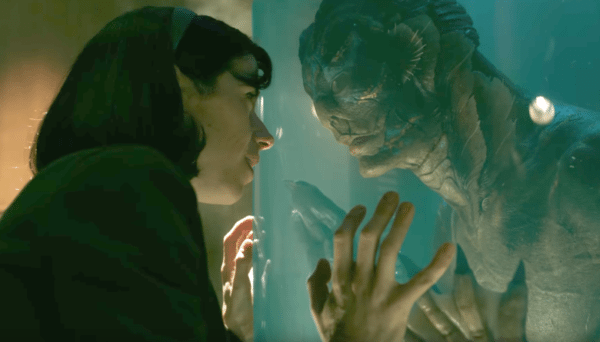The Shape of Water, 2017.
Directed by Guillermo del Toro.
Starring Sally Hawkins, Doug Jones, Michael Shannon, Octavia Spencer, Richard Jenkins, Michael Stuhlbarg, Nick Searcy, and David Hewlett.
SYNOPSIS:
At a top secret research facility in the 1960s, a lonely janitor forms a unique relationship with an amphibious creature that is being held in captivity.
Not many people know this, but the word “magic” has its roots in the Old Persian word “Magush,” which was typically used to describe priests. Despite the apparent religious context, though, its true meaning has to do with wisdom and helping people, traits that were commonly associated with said priests.
Watching Guillermo del Toro’s The Shape of Water, I couldn’t help but feel that the famed director was hearkening back to that version of the word when it came to implementing his magical touch. Though another one of his dark fantasies, there are no spells cast, no intricate netherworlds, and no mystic totems. What is here instead is a setting reminiscent of 1960s New York, when the United States and Soviet Union were at the height of the Cold War.
Del Toro has always been interested in tense political atmospheres, from post-Civil War Spain in Pan’s Labyrinth to the Reaper Virus in Blade II. I suspect this has to do with his own upbringing under a strict Catholic household: from an adult’s viewpoint, it is a simple dogmatic education; from the viewpoint of a child, however, it is an oppressive authoritarian nonage filled with images of sins and hellfire.
Del Toro has carried those evident feelings with him well into his career, culminating in The Shape of Water. He has frequently talked about how much of a cathartic experience making the film was: “For nine movies I rephrased the fears of my childhood, the dreams of my childhood, and this is the first time I speak as an adult, about something that worries me as an adult.” Cinema is his way of communicating with the world, and he does so with a tour de force craft.
With the Cold War era, it would have been easy to create a worldwide-affecting story similar to Pacific Rim, but here del Toro hones in on a single janitor named Elisa Esposito (Sally Hawkins), who makes a living cleaning a government building. For an unnamed reason, Elisa is unable to speak, instead using sign language understood by her close friends Zelda (Octavia Spencer) and Giles (Richard Jenkins). Despite these conversational limitations, Hawkins is absolutely phenomenal at conveying Elisa’s hopes, fears, loves, and interests, all of which light up when a specimen (Doug Jones) is brought to the laboratory. This thing is a humanoid creature, captured from South America where it was apparently worshiped as a God.
Because the military is interested in gaining an edge over the USSR, the fish monster’s captor Colonel Richard Strickland (Michael Shannon) is assigned the task of finding out everything he can about it. It would have been easy here to portray the Colonel as another strict dictator figure like Captain Vidal in Pan’s Labyrinth, but Shannon and Del Toro work to give him more depth than that by exploring his psychosis. This is a literal God-fearing man who wants to control everyone, but works in a system where he himself is under the control of the U.S. Government, represented by General Frank Hoyt (Nick Searcy). Shannon plays the antagonist as absolutely despicable, but you can’t help but wonder how he got to this point in life.
The rest of the supporting cast is great, indicated by Spencer and Jenkins earning Oscar nominations. However, significant props must be handed to Doug Jones. He has played many monsters in past Del Toro films, but somehow manages to make each one unique despite being hidden under all those heavy prosthetics.
Of course, the thrust of the film’s story is of the liaison that develops between Elisa and Jones’s so-called “Amphibian Man.” Both have strong similarities that make their connection natural: they are unable to verbally communicate with others, they are outsiders, and they are mistreated in this society. In one of the movie’s most beautiful scenes, Elisa has Giles transcribe her feelings about the Amphibian Man.
Unfortunately, there is an inherent problem with The Shape of Water, and the best way I can describe it is make a comparison to Cormac McCarthy’s The Road. The Road is a fascinating novel, but it is a hard book to translate to the big screen courtesy of its writing structure. It abandons all English grammatical rules, giving the text an animated quality. Though I enjoyed the movie adaptation, it faltered because of this aspect.
A similar case is present here. Del Toro clearly has some amazing cognitive ideas about the romantic relationship between Elisa and the Amphibian Man, but I was not entirely convinced of their bond. Romance films, especially contemporary ones, rest their believability on the passion between their characters. If the actors have good chemistry, even the dumbest plots will be enjoyable. Del Toro, on the other hand, is not interested in passion but of an instinctual relationship. Perhaps that is why Elisa is mute. If a vocal language was used, it would force the film to rely on dialogue instead of actions. Still, I wish he would have added a couple more scenes of them growing their friendship. Or perhaps he did, but they had to be trimmed to match a runtime.
These grievances are small, though. As he has done in his previous films, Del Toro has once again assembled a magical team to put together his magical ideas. The Shape of Water is a movie you should not miss.
Flickering Myth Rating – Film: ★ ★ ★ / Movie: ★ ★ ★
Red Stewart















